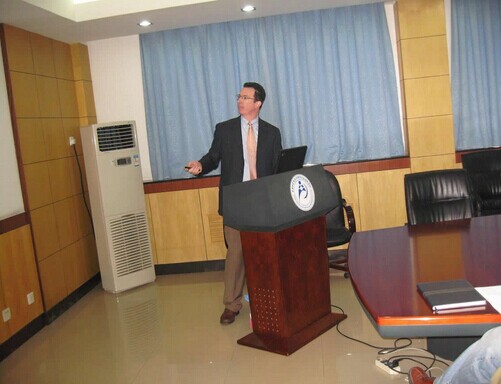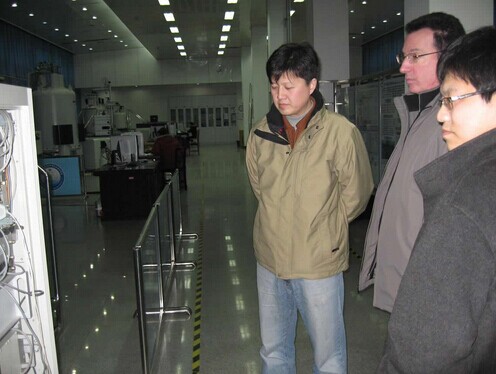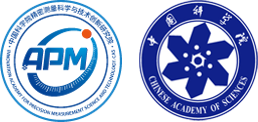

Dr. Mitchell Albert visited Wuhan Institute of Physics and Mathematics
In January 21st, 2011, invited by Professor Xin Zhou from WIPM, Dr. Mitchell Albert from American University of Massachusetts visited WIPM for 3 days and made a report entitled with "Hyperpolarized Gas MRI for Pulmonary and Neuro-Imaging Studies". Dr. Mitchell Albert is the professor of radiology department, University of Massachusetts and the director of MRI research center.
The conventional proton MRI technology can apply for almost all the parts of human body, but is unavailable in pulmonary .It is because most parts and tissues of human body are composed of water or fat, which have a high density of proton, making it possible to acquire enough MRI signal in magnetic field 1.5T or 3T usually used in hospital. However, most parts of human pulmonary are alveoli, which is empty with low density of proton (about 1/1000 of other tissues). Therefore, it is impossible to get enough MRI signal in pulmonary using conventional proton MRI technology. Hyperpolarized gas MRI is a new technology different with the conventional thermal poling MRI technology using laser pump and spin exchange collisions. With it he can greatly promote the degree of polarization of inert gas (3He, 129Xe)to increase the NMR signal of hyperpolarized gas more than 1000 times. Therefore, he can use this method to study the Structure and function of human pulmonary.
Dr. Albert introduced the application of hyperpolarized inert gas 3He in the study of asthma, emphysema, chronic obstructive pulmonary disease and lung cancer and the development of this method. As 3He is a scarce resource, making it extremely expensive, many countries start to control the sales of it. In addition, compared with 129Xe, 3He does not dissolve in the blood. However, 129Xe can dissolved in the blood circulation to the brain, providing us a new research method to do Neuro-Imaging Studies. Then he introduced his cooperation with Xin Zhou's group, which is the first to study stroke using hyperpolarized 129Xe MRI. This research is reported by the University of Massachusetts School of medicine as a website headlines (http://www. umassmed. edu /news /articles /2011 /stroke_imaging.aspx) . However, 129Xe's degree of polarization and gyromagnetic ratio is about 1/4 of 3He's, as a result, the signal of 129Xe is less than 1/10 of 3He, which is a great challenge of research of 129Xe MRI.
After the report, Dr. Albert visited the NMR lab. He was very interested in hyperpolarized 129Xe MRI instrument and self-developed 500MHz NMR spectroscopy and appreciates them. 6 years ago in 2004, Dr. Albert has visited WIPM, this time he expressed great admiration and appreciation for the development of China.

--The Academic Report--

--Dr. Albert visit the NMR Laboratory--

Innovation Academy for Precision Measurement Science and Technology, CAS.
West No.30 Xiao Hong Shan, Wuhan 430071 China
Tel:+86-27-8719-8631 Fax:+86-27-8719-9291
Email:hanyeqing@wipm.ac.cn
鄂ICP备15017570号-1